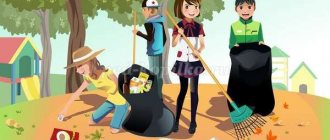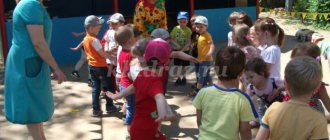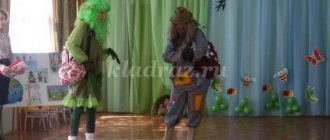Summary of the autumn ecological walk “Journey to the autumn forest.” Senior group
Ecological walk in the senior group of kindergarten “Journey to the autumn forest”
Name of the walk: “Journey to the autumn forest” Form of thematic walk: walk-hiking Age group: senior group Time of the walk: first half of the day Duration of the walk: 45 minutes Purpose: creation situations of children's development on the formation of ideas about late autumn through research activities. Objectives: • to promote the development of children’s ability to establish the relationship between air temperature and the state of living and inanimate nature, cause-and-effect relationships; • promote the development in children of the ability to identify the reasons for the changes that occur in late autumn in the life of plants and animals, to highlight the characteristic signs of the season; • create conditions for instilling in children love and respect for nature. Materials: sand, pebbles, cloth, watering can with water;
“traces” of animals and birds that can be put on your hands; sheets of black paper, magnifying glasses (for each child); a jar of water, a stick, a ball of thread, poplar and wild ranet branches with buds, leaves, a basin, a toy hedgehog, materials for creating a “Late Autumn” model and “drawing” with sand; key in a plate of water, glass, matches or lighter, plate; fortified drinks (chamomile, rosehip, mint, lemon balm) for treats. Progress
Educator: The days have become shorter, the nights have become longer. The fields are empty, the ground is wet, the rain is falling. Who can say, who knows, When this happens? Children. In autumn. Educator: Today we will go on a trip to the autumn forest, but first we will spend a little time at the edge of the forest and look at the sand. Experiments with sand, observations The goal is to create conditions for developing the ability to distinguish and name the properties of sand. Experience No. 1 Educator: Look carefully at the sand, touch it, pour it from palm to palm. Name the properties of sand. Children: Sand can be dry, wet, wet, very wet. The sand is loose and flows. You can sculpt from sand. It can be yellow, light brown, dark in color. Sand allows water to pass through it well. Educator: When we walk on dry sand, are we comfortable? (Children's answers.) Yes, very inconvenient. It is difficult to walk on dry sand, it crumbles and your feet sink into the sand. (The teacher asks one child to walk on the sand and talk about his feelings.) Can we sculpt from dry sand? (Children's answers.) Let's imagine that it is raining in autumn. (The teacher asks to choose a child who will be the rain; he must take a watering can and water the flower.) Where did the water go? Children: The water has soaked into the sand. Educator: Can we sculpt from raw sand? (Children's answers.) Is it comfortable to walk on it? (Children choose who will complete the next task.) Walk on the sand and talk about your feelings. Now wipe the shoes with a cloth. Guys, the child is gone, and what is left on the sand? Children: Traces. Educator: That's right, there are traces left. Take the “footprints” of animals and birds, put them on your hands and print them. Name those who walked. (Children's answers.) Guys, why is sand inconvenient for us now, here? Children: The sand remains on the sole. Observation No. 1 The goal is to create conditions for developing the ability to observe and draw conclusions that sand consists of grains of sand. The teacher puts a small handful of sand on a sheet of black paper and invites the children to examine the sand through a magnifying glass: the grains of sand are small, uneven, hard, different colors, round in shape, located separately from each other, and move easily. Educator: What is sand made of? Children: Sand consists of very small grains of sand. Observation No. 2 The goal is to create conditions for developing the ability to compare materials, correctly name their features, and conduct a sensory examination. Children pick up pebbles and sand, compare, stroke, feel, squeeze, and try to sprinkle. Listen to the sound of a stone falling, the rustling of a stream of sand. Educator: Name the properties of stones. Children: Rocks are hard. They can be smooth, rough, different colors and shapes. Educator: Grains of sand are tiny pebbles. They are formed when large rocks rub against each other. Experiment No. 2 Educator: Let's find out what is heavier: stones or sand? The teacher pours sand and stones into a jar of water and mixes with a stick. Children watch as materials settle to the bottom. They conclude: stones settle before grains of sand, they are heavier. Teacher in the forest. Hello, forest, dense forest, full of fairy tales and miracles! What are you making noise about in the leaves on a dark, stormy night? What are you whispering to us at dawn, covered in dew like silver? Who is lurking in your wilderness - What kind of animal? What bird? Open everything, don’t hide it: You see, we are our own! S. Pogorelovsky Game exercise “Continue the word” Educator: Let's prove to the forest that we belong. The teacher throws the ball to the child and says the beginning of the word, the child returns the ball and finishes the word. Fox, honey, mushrooms, hedgehog, leaf, squirrel, kA-ban, nuts, hare, tree, sun, flowers, etc. . “Rules of friends of the forest” Educator: Before the path takes us far into the forest, let’s remember the rules of friends of the forest. How should you behave in the forest so as not to harm its inhabitants? The child names the rule and takes his neighbor’s hand, who also names the rule and takes his neighbor’s hand, etc. Children: You cannot make fires in the forest. You cannot trample the grass and collect large bouquets of flowers. After a rest, you need to remove all garbage after yourself and do not leave it in the forest. There is no need to make noise in the forest so as not to disturb the animals and their cubs. You cannot destroy anthills: ants are of great benefit, they are forest orderlies. You cannot catch insects - butterflies, ladybugs - they pollinate plants and destroy aphids. Do not break branches of trees or bushes. If we find a hole in the forest, we must not come close, so as not to scare the forest inhabitants. Educator: Why is it necessary to know and follow the rules of conduct in the forest? (Children's reasoning.) Children's answers. (The forest is a home for animals. We must respect someone else’s home. Educator: How can we help the plants and birds on our site now? Children: Cover the tree roots with snow, hang feeders and feed the birds. Educator: We just said: you can’t then, you can’t do this... but what can you do in the forest? Children: You can walk quietly along the paths to hear the voices of the forest inhabitants, admire the plants - flowers, trees. You can watch a squirrel, a woodpecker. If we catch a grasshopper or an ant for observation, we will examine let's let him go. You can play ball in the forest. Educator: That's right, well done! Signs of late autumn (consolidation) The teacher names the sign of autumn and hands the ball of thread to the child, holding the thread in his hand. Children name the signs of autumn - the ball goes in a circle. Educator : The days are short, and the nights are long, dark. Children: A cold wind is blowing. The leaves have turned yellow and fallen. The birds have flown to warmer regions because there are no insects. The sun is shining, but it is not warm. It sometimes rains with snow. It became cold, children and adults were dressed in warm clothes. There are frosts. Dynamic pause “We will become trees” Children perform figurative movements according to the text. We will become trees, strong and big. Legs are roots, Let's spread them wider, so that they hold the tree, don't let it fall, and extract water from the distant depths. Our body is a mighty trunk, It sways a little, And with its sharp tip it rests against the sky. Our hands are branches, together they form the crown. In the canopy they are not at all afraid. When the winds blow hard. Your fingers will be like twigs. Leaves cover them. As autumn comes after summer - the leaves fly away instantly. Educator: Guys, please tell me how trees prepare for winter. Children: Trees and bushes have dropped their leaves so as not to give water or food - they themselves need strength to survive the winter. The leaves are thrown to the ground, under the roots, to cover them, and if they do not shed their leaves, the snow attacks them, and the branches break under its weight. Now we'll look at the kidneys. The trees stand without leaves, but there are buds (dense lumps), and they are dormant... what? (Children's guesses.) That's right, sticky notes! Examine the buds (shows branches with buds): what are they in shape, size, color? (Children's answers.) Compare the buds of poplar and wild ranetka. (Children's answers.) Do you think the trees are growing now? Children: No. The trees are at rest, they seem to be sleeping. Educator: Nothing in nature happens by chance. Trees need fallen leaves. Bushes in autumn and winter for drowning. And now the snow has covered them. Experiment with leaves Educator: Look how many leaves are under our feet! Walk around them. Do you smell anything? Children: Yes, it smells like leaves. Educator: Why did the leaves wither and dry up? (Children's guesses.) Take one piece of paper at a time. Look at the inside of the leaf - it is dotted with small dots. What it is? It turns out that leaves are the “windows” of trees. To live and grow, a tree needs a lot of water. The roots absorb water from the ground, then it rises along the trunk, branches and falls into the leaves. The sun heats the leaves, the “windows” open, releasing moisture - the leaf cools and dries out in hot weather. In late autumn, like now, at the end of November, the ground freezes. Little water flows into the tree, the sun does not get hot, and “window windows” are not needed. If in summer the leaves are firmly attached to the branch, then in the fall a plug is formed between the leaf and the branch - a partition. She separates the leaf from the branch; it does not adhere well to it. Even a slight breeze blows leaves off the branches. This is how leaf fall begins. Now put the leaves in a basin, water them from a watering can, as if it were raining. At the end we will see what happens to them (the leaves will become soft and will not rustle). Creating a “Late Autumn” layout and “drawing” with sand Educator: Guys, who is this sitting under the bush here? (Takes out a toy hedgehog.) The hedgehog is still small and does not know where it can spend the winter. Let's make a layout in late autumn, and you can tell me where it is and how it can overwinter. Whoever wants to, let them make a model, and the rest can prepare an autumn drawing for the guests - they will “draw” with sand. Children create a model and “draw” with sand. Experiment “Dry from the Water” The goal is to create conditions for demonstrating the existence of atmospheric pressure and the property of air when cooling to occupy a smaller volume (compress) Educator: Guys, look: in our forest the puddle has not frozen yet. The children look into the plate of water - there is a key there. Educator: Think and tell me how you can get the key without getting your fingers wet. Children offer different methods and test them. Educator: I propose to carry out an experiment according to the algorithm: light a piece of paper inside a glass. (The air has burned out. We tip the glass onto a plate, next to the key. After a while, the paper in the glass will go out, the air will begin to cool, and the water will gradually be drawn in by the glass, revealing the bottom of the plate. You can take the key with your fingers. Guys, tell me how it all happened? (Children's assumptions.) I repeat once again: the air first warmed up in the glass and expanded, excess air came out of the glass. When it began to cool, it became insufficient, and the air outside began to put more pressure on the water than in the glass. Under the pressure of the outside air ( air pressure) of water was drawn into the glass. Ecological cafe Educator: Children, what can we open with this key? (Children's answers.) They say that an unusual forest ecological cafe has opened nearby. I think the magpie tried to steal the key again, but dropped it. Let's open it cafe. Come. It is no coincidence that such a cafe opened in the forest. The forest is a home for animals, birds and insects. I think you guys know the inhabitants of the forest well. Let's start an environmental quiz ! 1. The animal is furry, clubfooted, and sucks its paw in the den. (Bear) 2. Sometimes red, sometimes gray, but by name - white. (Squirrel) 3. Cross-eyed, small, wearing a white fur coat and felt boots. (Hare) 4. Here are the needles and pins coming out from under the bench. (Hedgehogs) 5.Who walks around angry and hungry in the cold autumn? (Wolf) And now, girls and boys, turn around and turn into animals! P/i “Inhabitants of the Forest” (Children depict a bear, a hare, a wolf, a fox.) Reflection. Educator: Guys, it was difficult for you to complete your assignments. Carry out investigations? What did you like most? (Children's answers.)
And now I invite everyone to try fortified drinks.
We recommend watching:
Summary of an autumn walk with children of the middle - senior group of kindergarten. Summary of a walk to the park with children of the senior group. Outline of an autumn walk in the senior group Summary of an autumn walk for children in the senior group of preschool educational institutions
Similar articles:
Autumn walk “Watching the sun”. Senior group
Autumn walk in the senior group. Introduction to the work of a janitor in a preschool educational institution
Autumn walk in kindergarten in the senior group. Withered plants




